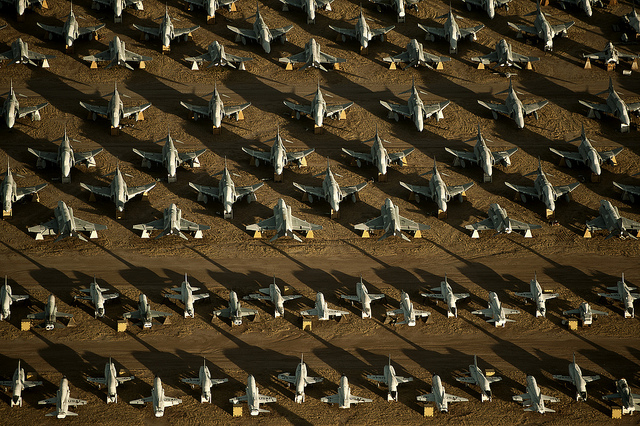
Date: 2026-01-22 Page is: DBtxt003.php txt00010410
Waste
International conflict, military hardware
Tragically Ironic: Military Planes That Put People in Graveyards Have Their Own Cemeteries
Burgess COMMENTARY
Peter Burgess
Tragically Ironic: Military Planes That Put People in Graveyards Have Their Own Cemeteries

Davis-Monthan Air Force Base in Tucson, a 'boneyard' for US military aircraft no longer in use. (Photo: Airman Magazine)
They are called 'boneyards' by military personnel, but they aren't human ossuaries. Instead, they are graveyards for machines that kill.
After the military-industrial complex's life-destroying aircraft complete their mission of death and decimation, they are replaced by newly designed Molochs of the sky. The multi-billion dollar equipment that is being phased out has to go somewhere - and most US military planes end up in what are nicknamed 'boneyards.' Generally, these are enormous swaths of desert in the Southwest of the United States.
'Outdated' combat - and other Pentagon - aircraft in 'boneyards' can be parked for years. Some of them are used for spare parts, some are scrapped, a few are occasionally called back to service and upgraded in times of large-scale war, and some are sold to foreign national military services. For the most part, however, these former killing machines simply become metallic bones.
How ironic.
An organization called The Center for Land Use Interpretation describes Tuscon's Davis-Monthan Air Force Base as 'the largest collection of aircraft on the planet':
There are around 4,500 airplanes here at any given time, covering nearly five square miles. It’s a fleet second only to the 5,500 active manned aircraft in the U.S. Air Force, and those, of course, are spread out all over the world, and still fly....
The range of aircraft at the boneyard is, of course, vast. Fighter jets, helicopters, surveillance aircraft, transport, tankers, and bombers. Even ICBMs have been handled here. Famously, 365 B-52s were eliminated here in the 1990s, as part of the START I treaty, their wings chopped off with a 13,000 pound guillotine, and later with saws. Many of the visibly disabled aircraft left exposed to Russian satellites for verification, remain so, mostly in Area 26.
A spot will no doubt someday be found to retire the latest innovation in raining down death: the current drones, which will certainly be replaced by more advanced technological models that will churn a large profit for aerospace manufacturers.
In Stephen Dowling's 2014 BBC article on the Davis-Monthan 'boneyard,' aviation author Nick Veronico talked about superannuated military aircraft as if they were spare body parts:
Each of the storage yards typically performs a variety of functions from storing aircraft that are temporarily out of service but expected to return to the fleet, to reclaiming useable parts which are inspected, overhauled, and then held until needed by active aircraft, to dismantling of the aircraft carcasses. These functions go hand-in-hand and are part of the lifecycle of an aircraft.
'I have flown on aircraft that have gone to the boneyard and provided parts to the fleet,' [Veronico] says. 'I’ve had the opportunity to watch parts being removed from a plane, and then having flown on an aircraft flying with salvaged parts – the exact parts I saw being removed, preserved, and installed.'
They aren't body parts, however. The body parts are scattered in conflicts across the globe in which these planes took part.
One need not look far for the bloody debris of human life, the death wrought by US bombings in recent years - including the deaths of Palestinians caused by the US aircraft used by the Israeli air force, and the militaries of other nations around the world.
Often, art profoundly conveys the gruesome disfiguration of life by war. Take Pablo Picasso's 'Guernica' painting (see below), for example, which provides his terrifying vision of the impact of the bombing of the Basque town of Guernica by the Nazis during the Spanish Civil War.

The bombing of Guernica, by Pablo Picasso. Painted in 1937. (Photo: Manuel Galrinho)
When people are dismembered by exploding bombs, they can't be used as spare parts. Their lives have been obliterated. The Middle East, for more than a decade, has been littered with real boneyards like the one depicted in Picasso's 'Guernica,' but on a more massive scale.
The killing machines that end up in 'boneyards' may be upgraded, refurbished and flown again. The victims of bombing, however, cannot be brought back to life.
Not to be reposted without permission of Truthout.